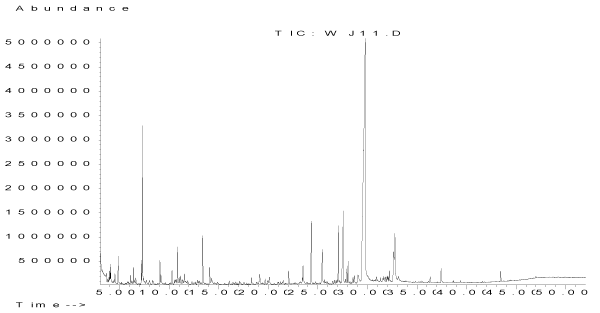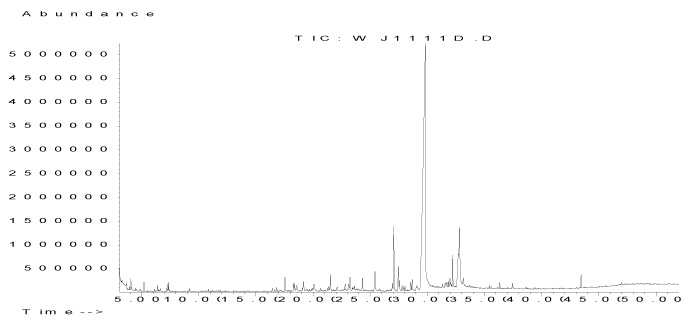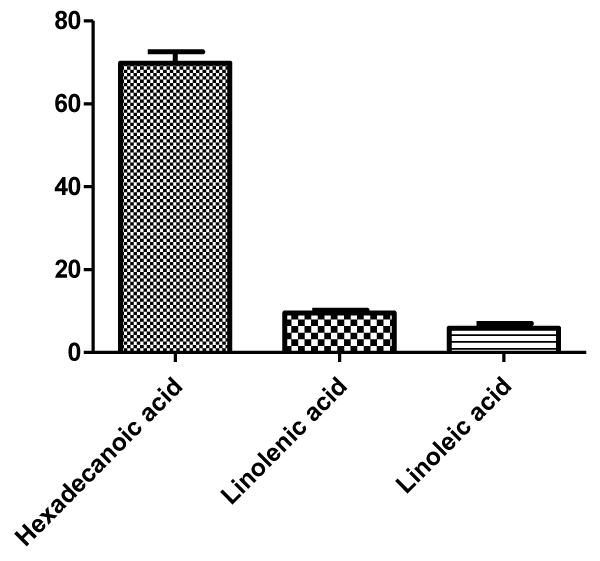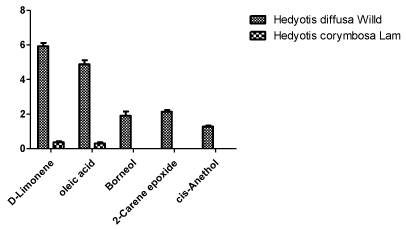International Journal of Pharmaceutical Sciences and Developmental Research
Comparative Chemical Composition of the Essential Oils from Hedyotis Diffusa WILLD and Hedyotis Corymbosa Lam by GC-MS
Wu Jian1, Yang Tairan2, Xu Ying1, Zhang Yi3 and Xiang Zheng1*
2Yingkou Institute for Drug Control, Yingkou 115000, PR China
3Sun Yai-Sen memorial hospital, Sun Yai-Sen University, Department of Good Clinical Practice, Guang Zhou 510120, PR China
Cite this as
Jian W, Tairan Y, Ying X, Yi Z, Zheng X (2016) Comparative Chemical Composition of the Essential Oils from Hedyotis Diffusa WILLD and Hedyotis Corymbosa Lam by GC-MS. Int J Pharm Sci Dev Res 2(1): 001-005. DOI: 10.17352/ijpsdr.000004Introduction: Hedyotis diffusa Willd. (Baihuasheshecao) is an ingredient of herbal commonly consumed in China for cancer treatment and health maintenance. In the market, this ingredient is frequently adulterated by the related species Hedyotis corymbosa Lam.
Methods: The objective of this comparative research is to study the chemical composition of the essential oils from Hedyotis diffusa WILLD and Hedyotis corymbosa Lam by GC-MS.
Results: In total, 43 components were identified in Hedyotis diffusa Willd. The identified components comprised 11 alcohols, 7 alkenes, 5 ketones, 7 aldehydes, 6 acid substances, 2 esters, 5 other substances. The major components in the Hedyotis diffusa WILLD oil were Hexadecanoic acid (48.89%) followed by Pentadecanoic acid (6.11%), D-Limonene (5.74%) and fatty acid were the most abundant components in Hedyotis diffusa WILLD. 32 components were identified in Hedyotis corymbosa (L.) Lam. The identified components comprised 2 alcohols, 8 alkenes, 4 ketones, 1 aldehyde, 6 acid substances, 6 esters, 5 other substances. The major components in the Hedyotis corymbosa (L.) Lam oil were Hexadecanoic acid (64.93%) followed by Linolenic acid (7.62%), Linoleic acid (3.73%). Borneol, 2-Carene epoxide, cis-Anethol, three compounds were identified exclusively in Hedyotis diffusa Willd.
Conclusion: This study showed that the chemical composition of the essential oils from Hedyotis diffusa WILLD and Hedyotis corymbosa Lam GC-MS were different. Borneol, 2-Carene epoxide, cis-Anethol, three compounds were identified exclusively in Hedyotis diffusa Willd. This study is significant for better quality control of this common herbal ingredient.
Abbreviations
GC: Gas Chromatography; MS: Mass Spectrometer; TCMs: Traditional Chinese Medicines; TLC: Thin Layer Chromatography; HPLC: High Performance Liquid Chromatography; ITS-1: Internal Transcribed Spacer 1; ITS-2: Internal Transcribed Spacer 2; FID: Flame Ionization Detector;
Introduction
The herb of Hedyotis diffusa Willd. (Synonym Oldenlandia diffusa (Willd), family Rubiaceae), is an annual herbaceous plant distributed in northeastern Asia and southern regions of China [1]. It has been commonly consumed for health maintenance and also as a dietary medicine for the treatment of prostate cancer [2]. Scientific studies also showed that Hedyotis diffusa WILLD possessed anti-cancer property, and its effects were related to the stimulation of the immune system, activation of caspase and burst of superoxide [3-6].
In the market, this ingredient is frequently adulterated by the related species Hedyotis corymbosa Lam [7]. Although these two Hedyotis species are not closely related sister groups from the phylogenetic point of view, they look very much alike even in fresh. The best harvest time of Hedyotis diffusa WILLD and Hedyotis diffusa WILLD were both November. They differ only by the shape of stems, number of flowers and size of pedicels, and these characters were difficult to observe when the materials are dried, cut or pulverized [8].
In order to ensure effective and correct use of Hedyotis diffusa WILLD, it is necessary to develop efficient methods for the quality control of Hedyotis diffusa WILLD. Various attempts were made using chemical methods to authenticate Hedyotis diffusa WILLD by thin layer chromatography (TLC) and high performance liquid chromatography (HPLC). However, these studies relied on unidentified spots or markers. DNA sequences of the internal transcribed spacer 1 (ITS-1) and internal transcribed spacer 2 (ITS-2) regions were separately proposed to distinguish Hedyotis diffusa WILLD derived from Hedyotis corymbosa Lam [9-11]. The accuracy of these sequences, however, has not been confirmed and complicated. Therefore, it is necessary to develop a simple and rapid analyse method for the quality control of Hedyotis diffusa WILLD. In this study, we study the chemical composition of the essential oils from Hedyotis diffusa WILLD and its adulterants Hedyotis corymbosa Lam by GC-MS.
Materials and Methods
Chemicals and reagents
Ethyl acetate (HPLC grade) was purchased from Kermel (Tian Jin, China). Purified water named ‘Wa ha ha’ was purchased from carrefour (Harbin, China). Hedyotis diffusa WILLD and Hedyotis corymbosa Lam were collected in Fujian Province (China) and were verified as the genuine medicinal herbs by Professor Shu-liang Yang of Harbin University of Commerce. All the voucher specimens authenticated are kept in our department for future reference. The air-dried samples were pulverized and the powders were screened through 40-mesh sieves.
Oil isolation
The powders of Hedyotis diffusa WILLD (20g) and Hedyotis corymbosa Lam (20g) hydrodistilled separately using a clevenger type apparatus for 4 h. The oils were collected, dried over anhydrous sodium sulphate and stored at 4ºC until analyzed.
Analysis of the essential oils
The oils were analyzed by GC-FID using an Agilent 6890 Gas Chromatograph with an Elite-1 capillary column (cross bond 100% dimethyl polysiloxane, non-polar, 30 m x 0.32 mm x 0.25 mm) fitted with Flame Ionization Detector. Helium was used as the carrier gas at flow rate of 1mL/min. The oven temperature programme was 55ºC for 2 min, programmed to 265ºC at a rate of 5ºC/min. The injector and detector temperatures were programmed at 220ºC and 250ºC, respectively. The analysis was performed three times (each time 50 minutes) and relative percentages of components as mean values were calculated from the peak area-percent of GC-FID data. GC/MS analyses of the oils were performed by split less injection of 1.0 mL of the oil on a Hewlett Packard 6890 gas chromatograph fitted with a cross-linked 5% PH ME siloxane HP-5 capillary column, 30 m x 0.32 mm, 0.25 mm coating thickness, coupled with a model 5973 mass detector. GC/MS operation conditions: injector temperature 220ºC; transfer line 290ºC; oven temperature programme 55–265ºC (5ºC/min); carrier gas: He at 1.0 mL/min. Mass spectra: Electron Impact (EI+) mode 70 eV with a mass range of 40 to 450 m/z, ion source temperature 250ºC. GC/MS chromatograms are shown in Figure 1 and Figure 2. Individual components were identified by Wiley 275.L and NIST05a.L database matching and by comparison of retention times and mass spectra of constituents with published data, are shown in Table 1 and Table 2.
Results and Discussion
Characterization of essential oil components in Hedyotis diffusa WILLD and Hedyotis corymbosa (L.) Lam
The oil yields of Hedyotis diffusa WILLD and Hedyotis corymbosa (L.) Lam were 0.1(v/w). The oil colors of the both samples were light yellow. Essential oil components in Hedyotis diffusa WILLD: In total, 43 components were identified. The identified components comprised 11 alcohols, 7 alkenes, 5 ketones, 7 aldehydes, 6 acid substances, 2 esters, 5 other substances. The major components in the Hedyotis diffusa WILLD oil were Hexadecanoic acid (48.89%) followed by Pentadecanoic acid (6.11%), D-Limonene (5.74%) (Figure 3) and fatty acid were the most abundant components in Hedyotis diffusa WILLD.
Essential oil components in Hedyotis corymbosa (L.) Lam: In total, 32 components were identified in Hedyotis corymbosa (L.) Lam. The identified components comprised 2 alcohols, 8 alkenes, 4 ketones, 1 aldehyde, 6 acid substances, 6 esters, 5 other substances. The major components in the Hedyotis corymbosa (L.) Lam oil were Hexadecanoic acid (64.93%) followed by Linolenic acid (7.62%), Linoleic acid (3.73%) (Figure 4) and fatty acids were the most abundant components in Hedyotis corymbosa (L.) Lam. In particular, Hexadecanoic acid were dominant in both oil samples, and their fatty acids, such as Linoleic acid, Hexadecanal, Tetradecanoic acid, Tetradecanoic acidethyl hexanoate, and Methyl hexadecanoate, were also identified as major components. These results are similar to those reported previously for Hedyotis diffusa WILLD and Hedyotis corymbosa (L.) [12].
According to the results presented here and those reported previously, there are some similarities between the Hedyotis diffusa WILLD and Hedyotis corymbosa (L.) Lam. On the other hand, the present study found that the contents of phytol and linolenic acid were higher in the Hedyotis corymbosa (L.) Lam than in the Hedyotis diffusa WILLD (Figure 5), while the content of D-Limonene, Borneol, 2-Carene epoxide, cis-Anethol, oleic acid was higher in the Hedyotis diffusa WILLD than in the Hedyotis corymbosa (L.) Lam, and the Borneol, 2-Carene epoxide, cis-Anethol were identified exclusively in Hedyotis diffusa WILLD.
Conclusion
Correct use of ingredient is important for quality assurance of traditional Chinese Medicals. In this study, we have successfully applied GC-MS technique for the comparative study chemical composition of the essential oils from Hedyotis diffusa WILLD and its adulterants Hedyotis corymbosa Lam. The identification of the herbal ingredient Hedyotis diffusa Willd and Hedyotis corymbosa Lam was different. Accordingly, Borneol, 2-Carene epoxide, cis-anethol, these compounds were identified exclusively in Hedyotis diffusa WILLD. The method is simple, rapid and the results were accurate and reliable, the proposed method was promising to improve the quality control of Hedyotis diffusa Willd H. his strategy employed may be extended to other medicinal materials.
The authors would like to thank Prof. Shu-liang Yang for identification of the plant material. Wu Jian was supported by scientific research task of Harbin University of Commerce PH.D starting project (92508145).
- Chun YY, Fan ShK, Ou XL (2012) Antioxidant and anti-glycated activities of polysaccharides in vitro isolated from hedyotis diffusa willd. J Med Pla Res 6: 2895-2900.
- Liang XY (2004) A case of prostate cancer treated with Chinese medicines. Aca Per Chang Col TCM 2: 29-34.
- Gupta S, Zhang D, Yi J, Shao J (2004) Anticancer activities of Oldenlandia diffusa, J Her Pha 1: 21–33.
- Willimott S, Barker J, Jones LA, Opara EI (2007) Apoptotic effect of Oldenlandia diffusa on the leukaemic cell line HL60 and human lymphocytes. J Eth 114: 290–299.
- Shan BE, Zhang JR, Du XN, Li KX (2001) Immunommodulatory activity and anti-tumor activity of Oldenlandia diffusa in vitro. Chi J Int Tra Wes Med 21: 370–374.
- Yadav SK, Lee SC (2006) Evidence for Oldenlandia diffusa-evoked cancer cell apoptosis through superoxide burst and caspase activation. J Chi Int Med 4: 485–489.
- Zhao ZZ, Huang WH, Wu JL, Yu T, Huang RD (2005) Easily Confused Chinese Medicines in Hong Kong. Chi Med Mer Ass 6: 145-149.
- Guo X, Simmons MP, But PP, Shaw PC, Wang RJ (2011) Application of DNA barcodes in Hedyotis L. J Sys Evo 3: 203–212.
- Lau CB, Cheng L, Cheng BW, Yue GG, Wong EC, et al. (2012) Development of a simple chromatographic method for distinguishing between two easily confused species Hedyotis diffusa and Hedyotis corymbosa. Nat Pro Res 15:1446–1450.
- Li M, Jiang RW, Hon PM, Cheng L, Li LL, et al. (2010) Authentication of the anti-tumor herb Baihuasheshecao with bioactive marker compounds and molecular sequences. Food Che 3: 1239–1245.
- Yu J, Li M, Guo X, Wang RJ, Chiu SW, et al. (2012) Value of FINS depends on choice of DNA locus as shown in Baihuasheshecao, J Food Drug Ana 4: 879–886.
- Jin-Fang HU, Wen-Wen Y, Shuai Y, Wen-Jie Y, Yan-Qun L, et al. (2013) Optimization of Supercritical Carbon Dioxide Extraction Conditions for Hedyotis diffusa by Orthogonal Test and GC-MS Analysis. Chi J Exp Tra Med For 5: 96-100.
Article Alerts
Subscribe to our articles alerts and stay tuned.
 This work is licensed under a Creative Commons Attribution 4.0 International License.
This work is licensed under a Creative Commons Attribution 4.0 International License.







 Save to Mendeley
Save to Mendeley
